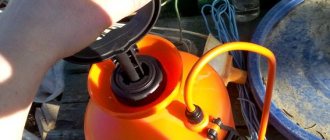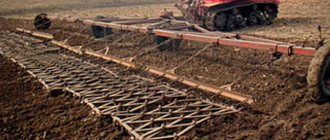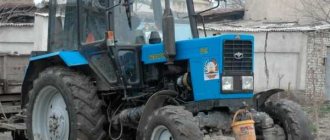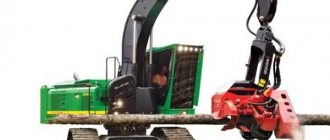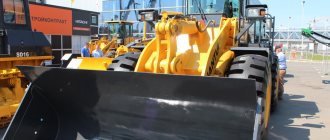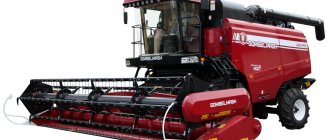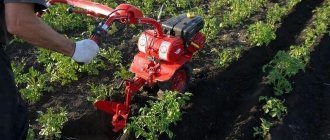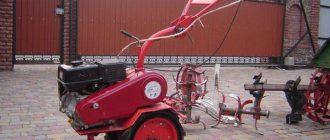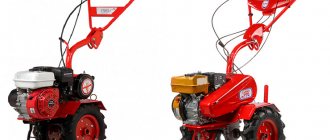Yuri Petrov
Part 1 Part 2 Part 3 Part 4 Part 5 Part 6
In the period 2000–2004, many well-known manufacturers abandoned the production of reach stackers, including Boss, Madal, Hyco. In fact, brands such as PPM, P&H, Belotti and Valmet have been withdrawn from the reach stacker market; the “budget” brand Sisu has an uncertain future. It would seem that it’s time to say: a holy place is never empty, but this is a special case.
Most of the new manufacturers are located in America and the Asia-Pacific region, where the position of traditional European companies is not so strong. Market leaders are also not asleep and open machine assembly and partial production locally, and in addition, sell equipment under the brands of interested partner companies or delegate distribution authority (as, for example, Terex-PPM does, which transferred the privilege to the Indian trust Voltas from Mumbai represent your brand in the markets of Indochina and Southeast Asia).
Komatsu
HX series reach stackers from Komatsu Forklift Co., Ltd. extremely rare to see in places other than the Land of the Rising Sun, and, objectively speaking, these cars are not even Japanese. The Komatsu range of reach stackers was originally developed by the Italian company CVS Ferrari in 1998 under a special production agreement for the Japanese, Korean and Chinese markets. Thanks to this cooperation, the Japanese “zaibatsu” retained its reputation as the number one national manufacturer of special equipment in the region, having mastered a new segment of the material handling equipment market, and a genuine manufacturer from the Apennines clearly indicated its presence in the Asia-Pacific region by preparing a line of unique machines.
During 1999–2005, modified mid-size CVS Ferrari reach stackers were introduced under the Japanese giant's brand, which were adapted to work primarily with 20-foot containers and 40-foot containers of limited weight. This is explained by the logistical features of the management system in the local market: Far Eastern operators work with large and wholesale consumers, whose supply system for raw materials and equipment is standardized and planned for many months and years in advance. Under these conditions, the weight of the containers is already known in advance, but even under normal conditions it extremely rarely reaches the limit value of 25 or 45 tons. Based on this, the rated load capacity of the machines can be optimized for specific needs, also reducing the material consumption and cost of the product. The load capacity of Komatsu models for different loaders is 40 or 30 tons in the 1st row and 30, 25 and 20 tons in the 2nd row. All reach stackers are adapted to work with containers with a height of 9' 6'' (2896 mm) on the fifth tier, and only some are adapted to work on the sixth tier, but with containers of a lower height - 8' 6'' (2591 mm).
Komatsu HX Series reach stackers are based on one basic loader model with a wheelbase of 6500 mm.
All reachstackers are equipped with spreaders with top-mounted containers in fittings, and some CVS Ferrari models are equipped with piggy-back spreaders (with a bottom grip), intermodal type, as well as a side grip for handling two containers at the same time. Brief characteristics of Komatsu reach stackers
| Model | Load capacity max., t, in 1st/2nd row | Number of tiers of 9'6″ containers in 1st row | Wheelbase, mm | Tires |
| F4025M5-1 | 40/ 25 | 5 | 6500 | 18.00-25 |
| F3025M6-1 | 30/ 25 | 6* | 6500 | 18.00-25 |
| F4030M5-1 | 40/ 30 | 5 | 6500 | 18.00-25 |
| F4030M5H-1** | 40/ 30 | 5 | 6500 | 18.00-25 |
| F3030M6-1 | 30/ 30 | 6* | 6500 | 18.00-25 |
| F3030M6H-1** | 30/ 30 | 6* | 6500 | 18.00-25 |
| F4035L5-1 | 40/ 35 | 5 | 6500 | 18.00-33 |
| F4035L5H-1** | 40/ 35 | 5 | 6500 | 18.00-33 |
| F3030L6-1 | 30/ 30 | 6* | 6500 | 18.00-33 |
| F3030L6H-1** | 30/ 30 | 6 | 6500 | 18.00-33 |
| F4035L5V-1 | 40/ 35 | 5* | 6500 | 18.00-33 |
| F4035L5VH-1** | 40/ 35 | 5 | 6500 | 18.00-33 |
*Number of tiers when working with 8'6″ containers. **Equipped with an intermodal spreader.
Main manufacturers
The majority of reach stacker manufacturers are European companies, since it was in this part of the world that the problem of fast handling of containers during cargo transportation in the conditions of a large number of intermediate warehouses and small terminals arose earlier and more acutely. Nowadays the best reach stackers are supplied by such companies as:
- CVS Ferrari;
- Fantuzzi;
- Ormig;
- Linde;
- Hyster;
- Liebherr.
Manufacturers have established themselves as leaders in the lifting equipment market. All their products meet the requirements assigned to them and ensure fast and uninterrupted container transshipment.
Mitsubishi
Another diversified concern, Mitsubishi Heavy Industries, Ltd., has recently become interested in the production of reach stackers. The first mention of a new line of port equipment appeared in a technical review of the concern in February 2005, and practically nothing was known about it. More complete information appeared only this year on the website of Grendia, which is a sub-brand of Mitsubishi Heavy Industries (MHI) loaders.
Preliminary research on the reach stacker market conducted by analysts from the MHI engineering group showed that it is more appropriate to use a universal machine with the following lifting capacity characteristics:
- 1st row (1st..4th tier) – 45 t;
- 1st row (5th tier) – 42 t;
- 2nd row (1..4th tier) – 29 t;
- 3rd row (1st..3rd tier) – 15 t.
During trial operation, it turned out that there is no point in increasing the load capacity, since in the 1st and 2nd rows the weight of the processed container under normal conditions is 30.5 tons.
The Mitsubishi range of reach stackers includes two models RS420 and RS450 for handling 42- and 45-ton loaded containers respectively. The rotary spreader with top grip allows you to handle 20- and 40-foot containers at the fifth tier level. The lifting capacity of the RS420 model on the upper floors is 40 tons, and the RS450 model is 42 tons. Both models use the same platform and are almost identical in appearance. Their wheelbase is 6 m, overall dimensions are 11,160x4170x4490 mm. The versatility of the Japanese concern allowed it to use its own components for the reachstacker, starting with the driver’s seat and ending with a proprietary engine-transmission unit. It should be noted that the used Mitsubishi engine of the 6D24-TL series is already becoming the base engine for other Asian reach stacker manufacturers. They are equipped with TCM and Dalian loaders.
Through an electronic control system and network data transmission in CAN-BUS reach stackers, data on the operation of all units and mechanisms is displayed on an LCD monitor. The operator's cabin is made movable for various operations on loading and unloading containers, including rail and road transport.
The boom is mounted on a double rear leg and is driven by two telescopic hydraulic cylinders. The spreader rotates in plan at an angle of +95°..–185° and moves relative to the boom by 800 mm in each direction. The hydraulic drive of the boom, spreader, machine travel and wheel rotation is carried out by several independent pumps, which allows you to perform several operations simultaneously.
Brief characteristics of Mitsubishi reach stackers
| Model | Number of tiers of containers 8′ 6″ in 1st/2nd/3rd row | Load capacity max., t, in 1st/2nd/3rd row | Curb weight, t | Total weight, t | Engine | Engine power, hp | Transmission | Tires |
| RS420 | 5/ 4/ 3 | 42/ 25/ 11 | 67 | 109 | Mitsubishi 6D24-TLE2A | 330 at 2200 min–1 | Mitsubishi MT731A | ORS18.00-25 36PR |
| RS450 | 5/ 4/ 3 | 45/ 30/ 15 | 71 | 116 | ORS18.00-25 40PR |
TCM
Tokyo-based TCM Corporation was founded in 1949, and this year celebrates the four-year anniversary of the launch of its first reach stacker (previously it was a regional sales agent for Kalmar ContChamp reach stackers in its region). TCM, best known as a manufacturer of wheel loaders, forklifts and skid steers, also produces a wide range of utility, snow removal, mining equipment, underwater tractors, articulated dump trucks, slag and iron trucks, ro-ro conveyors, conveyor equipment and technological transport for metallurgy. For ports, the company produces the widest range of equipment, ranging from gantry and quay cranes to terminal tractors, which are produced at the Ryugasaki-shi plant.
The lifting capacity of the MR420 series machines, like the Komatsu reach stackers manufactured by TCM Corporation, is limited to 42 tons, although the 45-ton MR450 loader can also be manufactured upon special order. The basic model TCM MR420 became the first Japanese reach stacker with the “Made in Japan” stamp, but it is still equipped with many European components, the production of which is not common in Japan: first of all, the ELME spreader, Meritor PRC7534W4H axles (previously also installed by Kessler) and tires GoodYear 18.00-25 (36- or 40-ply).
The six-cylinder Mitsubishi 6D24-TL turbodiesel with a displacement of 11,945 cm3 is coupled with a four-speed reversible automatic proprietary transmission TCM TM350, which allows it to reach speeds of up to 25 km/h.
The TSLS general load safety system makes it possible to obtain information about the weight, height and distance to the load. The clamps are equipped with locking locks in the fitting and prevent accidental release of the container while suspended. The two-section Tadano boom allows you to “carry” 45-foot containers in a longitudinal state into closed warehouses for safekeeping (height at the top point of the boom is 6.3 m). The spreader rotator makes it possible to rotate the container in plan at an angle of +95°..–185° and move it relative to the boom by 800 mm in each direction. The hydraulic system provides high speed of lifting (400 mm/s) and lowering the load (230..300 mm/s).
The operator's cab located in the base manually slides 2.1 m, providing forward visibility and access under the hood.
The all-round visibility cab features a KAB 411 multifunctional operator's seat with air suspension and armrests. As an option, reach stackers are equipped with a TV terminal for viewing closed areas and a recoil system. Brief characteristics of TCM reach stackers
| Model | Number of tiers of containers in the 1st/2nd/3rd row | Load capacity max., t, in 1st/2nd/3rd row | Overall length, mm | Weight, t | Engine | Engine power, hp |
| MR420/4 | 4/ 4/ 3 | 42/ 25 /11 | 10 900 | 64 | Mitsubishi 6D24-TL | 270 at 2100 min–1 |
| MR420/4* | 4/ 4/ 3 | 42/ 34 /16 | 11 400 | 70 | Mitsubishi 6D24-TL | 330 at 2100 min–1 |
| MR420/5 | 5/ 4/ 3 | 42/ 30 / 16 | 11 600 | 71 | Mitsubishi 6D24-TL | 330 at 2100 min–1 |
| MR450 | 5/ 4/ 4 | 45/ 31/ 15 | 11 600 | 75 | Mitsubishi 6D24-TL | 330 at 2200 min–1 |
*Model with outriggers.
We agree on all technical indicators in advance based on the volume of containers at a specific site
The lifting capacity of a container crane or loader is determined by its maximum weight, taken to the maximum lifting height, which does not violate the stability of the entire mechanism. Large terminals and ports that handle loaded containers have the heaviest container lifting equipment. The more weight reserve a reloader has, the easier it does the job, but the terminal does not need to purchase a cargo unit to lift 60 tons if the maximum weight of containers , the turnover of which is provided for in the design documentation, does not exceed 35 tons. With all the variety of devices, ports are required to have at their disposal cranes capable of loading and unloading containers from seagoing vessels. For quayside container cranes, the outreach of the jib is important. The wider the vessel the terminal is ready to handle, the higher the container turnover. For railway stations, on the contrary, the crane or material handler must be compact or maneuverable. To provide a container unloading front on several exhibition routes at once. Such mechanisms include gantry and bridge cranes with spreader grip and self-propelled container loaders of the KALMAR type.
Dalian
One of the oldest forklift manufacturers in China, Dalian Forklift Co., Ltd. At one time it was the only OEM manufacturer of reach stackers in all of continental Asia. The company is named after the city of Dalian (Dalniy port), where its main production is concentrated.
Until recently, the Dalian Forklift production program included two models with a lifting capacity of 42 and 45 tons, but recently the FD420BZ4 model, designed to work with 42-ton containers, has been withdrawn from the production program, and all efforts are aimed at promoting the more powerful and advanced CRS450Z5 model . Both vehicles are designed according to a scheme that has become classic: the front wheels are driven, the rear wheels are rotary, the diesel engine is in the center, two hydraulic cylinders drive a telescopic box-section boom, the cabin is mounted on a frame in the middle of the body. The ELME 817 spreader installed on the Dalian CRS450Z5 is similar to that installed on the Liebherr LRS 645 reach stackers. The lateral movement of the spreader is ±800 mm, the horizontal rotation is +195°..–105°. The load capacity characteristics of the CRS450Z5 are at the level of world analogues, which allows this model to be successfully exported, including to Russia. Dalian Forklift machines boast high build quality, confirmed in 1996 by a certificate of compliance with ISO 9001, and favorable delivery conditions, supported by the general economic development of China and the increasing share of container transportation in Indochina.
Brief characteristics of Dalian reach stackers
| Model | Number of tiers of 8'6″ containers in 1st/2nd/3rd row | Load capacity max., t, in 1st/2nd/3rd row | Center of gravity height, mm | Weight, t | Engine | Engine power, hp | Torque, Nm | Lifting height, mm |
| FD420BZ4 | 4/ 4/ 3 | 30.5/ 25/ n.a. | 1220 | 65 | Mitsubishi 6D24TCE1 | 310 at 2000 min–1 | 1187 at 1400 min–1 | 9,5 |
| CRS450Z5 | 5/ 4/ 3 | 45/ 31/ 15 | 1900 | 73 | Cummins M11-C330 | 335 at 2100 min–1 | 1458 at 1300 min–1 | 14,85 |
Reach stackers are loaders for handling containers. Description.
It is quite natural that progress in the field of creating technology for reloading and transporting containers within covered storage areas also did not stand still. Since the beginning of the use of containers in the 1950s, technological equipment and means of mechanization of loading, unloading and transport and storage operations in large terminals have undergone significant changes. hyster ichstackers Initially, containers in terminals and ports were handled by gantry cranes, harbor terminal cranes, and heavy-duty forklifts. Subsequently, due to the increased flow and increased carrying capacity of containers, specific machines were required. The gantry cranes, straddle carriers and shuttle carriers developed for this purpose had a high lifting capacity, and the shuttle container ships were also highly maneuverable. Until the mid-1990s, they were the main type of equipment in port container handling operations, but recently they have begun to be replaced by reach stackers - specialized loaders originally designed only for operations with containers.
Why are reach stackers needed?
reachstackersanyApproximately 2,000 reachstackers are sold around the world every year, and the total fleet reaches 15 thousand. Reach stackers are rarely found on the secondary market, since they are initially purchased for specific operating conditions and in accordance with long-term business plans. The use of reach stackers makes it possible to speed up the processing of containers at intermediate warehouses and in terminals with low cargo consolidation, reduce the cost of servicing containers and thereby strengthen the position of an individual port, region or even country in the transportation of goods. The reach stacker SMV SC 4545 TA with a forward cabin and an L-shaped boom is specially designed for loading containers into the hold of a river vessel
For Russia, which occupies a special geopolitical position and has an acute shortage of terminals within the country, this is now most relevant. Unfortunately, the share of container transportation in Russia is only 1.3% of all cargo transportation, although the transportation of one container brings about 1000 USD in profit, and container transportation itself in most developed countries occupies a strategic position in the organization of internal and external cargo turnover.
reach stacker in the port The appearance of reach stackers in the early 1970s was due to several circumstances. To operate traditional systems and equipment of cargo areas, it was necessary to maintain expensive infrastructure, which paid off only for large volumes of cargo transshipment and was of little use for terminals with low cargo turnover. Due to a number of requirements, large-tonnage mast loaders, including those with forks, were also not always suitable for working with containers. In general, the lifting and transport equipment listed above had a significant drawback: it was designed exclusively for work in base ports on main routes.
There were other critical parameters in the operation of this technique. Traditionally used technology could not unfold the container during transportation or stacking (this is required, for example, to place the container in a closed warehouse or secure storage hangar), it is difficult to use in cramped or unsuitable conditions, as well as when working in intermodal warehouses with several modes of transport - railway, road and water, as well as in feeder ports with small volumes of traffic.
reach stacker installs containerMeclift ML5016SR - the world's only side-loading reach stacker
The share of such mini-terminals is even now growing, as the number of container traffic increases. Currently, in a number of countries, up to 90% of all cargo is transported in containers (excluding pipeline transport). The entire range of terminal equipment is in demand in the ports of these countries. Depending on the cargo handling technology and logistics features, reach stackers are assigned the role of auxiliary or main transport.
The container business today is one of the most promising and fastest growing. Large carriers who cannot afford to maintain large terminals, but are in dire need of cargo handling equipment, have become interested in it. In all respects, the use of a reach stacker is one of the most flexible methods of container handling, and in most cases, a reach stacker can replace forklifts, gantry trestle cranes, gantry and shuttle container ships in the port. However, despite the brightest prospects and seemingly favorable market conditions, reach stackers remain very expensive equipment. Their production cannot yet be called mass production, and most manufacturers, when accepting an order for the manufacture of a machine, require an advance payment from the client.
Design Features
Reach stacker Luna 8G for handling empty containers
A reach stacker is essentially a crane of sorts. The design of its lifting mast is not frame-based, like a traditional classic forklift, but is a telescopic boom, to which a special container gripping device is attached - a spreader. This design to some extent predetermined the history of the creation of this machine. By the mid-1960s, machine-building enterprises were already producing hydraulic truck cranes with high lifting capacity. As a first approximation, it was possible to take a standard crane, expand the support contour by increasing the gauge and base, and simply hang a spreader on the boom - a lifting mechanism for working with a container.
In practice, the ideology of designing a reach stacker for a number of reasons did not allow the use of a crane or loader with a telescopic boom that already existed at that time. The first limitation was that the reach stacker, unlike a truck crane, does not need to constantly use outriggers (hydraulic outriggers), and its overall width is limited only by the size of the cargo gate of a covered hangar (usually 6 m). The second condition is that the reach stacker must transport a 40-foot container weighing up to 45 tons and, if necessary, deploy it with a spreader, changing the position of the container relative to the longitudinal axis of movement. Thirdly, reach stackers are characterized by stable lifting characteristics and the ability to hold the container suspended while moving. Fourthly, the reach stacker operates in ports on a prepared hard road surface with minimal slopes, and this condition is taken into account when calculating the center of mass, steering mechanism and drive.
Liebherr LRS 645 for handling loaded containers and semi-trailers
The Swiss company Compact Truck AG tried to expand the capabilities of truck cranes on a special chassis for working with standard containers: in 1994, attempts were made to adapt the cranes to work with spreaders, but it never came to their mass use in ports. Currently, Compact Truck cranes under the Sokol brand are produced by the Baltic Construction Company, but their use is limited exclusively to construction work.
Due to a number of restrictions, a construction front loader with a telescopic boom cannot be fully used for working with containers. However, it is possible to combine the functions of a front loader, a truck crane and a reach stacker. This machine is called a “multistaker” because it is capable of working not only with containers, but also with packaged cargo. Instead of a spreader, a multistacker can use other types of quick-release working equipment: a hook clip, a rod for lifting cable drums, a combined lifting unit, a reel hook, a grab, a magnet, pallet forks, a grip for transporting pipes and assortments.
Modern reach stackers are made according to three main designs. The first and most common design is that the lifting boom is located longitudinally, and the lifting or sliding cabin is located in the base (the more common option) or extended forward. The second scheme is used for work related to loading directly into the hold of a river vessel or barge. In this case, the lifting boom is equipped with an extension ridge so that the container can be lowered below the level of the berth road surface, and the operator's cabin is moved forward, thereby providing the necessary visibility into the cargo handling area.
container warehouse and reach stacker Front loaders with a telescopic boom are sometimes used to handle empty containers
The third scheme is intended primarily for loading and unloading operations with containers transported on railway platforms or container trailers. Such reach stackers are equipped with their own loading platform, the cabin is moved forward, and the spreader is mounted on the side on two telescopic booms. Loading operations are performed only on the side.
Currently, reachstackers are produced by 14 manufacturers - exclusively foreign companies: Italian CVS Ferrari (formerly Belotti), Ormig and Fantuzzi, German Linde and Liebherr, Swedish Kalmar (an association of the Sisu and Valmet brands) and SMV, Finnish Meclift, Spanish Luna, Japanese TCM and Komatsu, Chinese Dalian and American Hyster and Terex (former PPM model range). The market for these cars cannot be called established: quite recently several companies, including the English Boss (this brand has been completely liquidated), the Brazilian Madal, the Italian Hyco and the Swedish Svetruck, have curtailed production for a number of reasons.
Device
The design of all modern reach stackers, with the exception of Meclift models, is similar: double hydraulic cylinders of the boom, two- or three-section telescopic boom with a rotary spreader mounted on it, electro-hydraulic control, water-cooled turbodiesel, hydromechanical or hydrostatic transmission, front drive axle and rear steered wheels , which are rotated by hydraulic cylinders. On request, the cabin on some models is mounted on a lifting frame or made mobile. The reach stacker, like a classic forklift, is protected by a counterweight from tipping over. The reach stacker has two of them - the main one and the additional one - and they are usually mounted in the base.
Reach stacker wheels are rotated using hydraulic cylinders
The working body of a reach stacker (automatic grab for containers) is a branchless spreader (i.e. without a flexible suspension, like cranes and conveyors with a portal), mounted on a lifting boom and usually equipped with a frame tilt mechanism with four degrees of freedom: tilt in the longitudinal and transverse planes, rotating the container in plan or changing the distance between the grips on the sliding frame. The latter makes it possible to compensate for the load on the grips when the container’s center of mass shifts, as well as to equalize the gaps between the rows of containers (this compensates for the inaccuracy of the reach stacker’s approach to the container row).
The operation of changing the distance between the grips is carried out by moving the transverse beams fixed to the sliding frame with corner locks. Universal spreaders are equipped with an individual or centralized electric or hydraulic drive of rotary locks - rotary pins, which, when seated on top in the slots of the four upper corner fittings of the container, are turned to an angle of 90°, thereby capturing it. In addition, auxiliary hanging frames are mounted on the spreader, designed to work with containers of a certain standard size. Since warehouses use not only universal containers, the spreader can be equipped with an adapter for processing special containers or car trailers. Spreaders are produced both by reach stacker manufacturers themselves and by third-party companies, such as the Dutch Stinis, the Swedish ELME and Bromma.
Reach stackers are effectively used at small intermodal terminals or for small volumes of work
The main characteristics of a reach stacker are load capacity and number of storeys when working with containers. Almost all manufacturers make reach stackers in a version for working with containers with a height of 2896 mm (9'6") and 2591 mm (8'6"). Moreover, if the reach stacker is capable of stacking six tiers of containers with a height of 2591 mm, then the same number of storeys will be when working with containers with a height of 2896 mm.
According to load capacity classes, reach stackers are divided into machines for handling empty and loaded containers.
The load control system installed on the spreader allows you to find out the weight of the container, displaying the indicator on the touch monitor in the operator's cabin. Recently, global monitoring systems based on Internet technologies, combined with a radio modem, have been built into reach stackers, allowing the cargo owner and base station operator to receive operational, technical and service information. Among other things, such systems allow you to track the movement of containers and keep records of them in real time. Return to list
Guangzhou
Guangzhou Port Machinery Industry Corp. includes two large factories: Panyu Nanyue Machinery Manufacturing factory in Guangzhou and Nanhai Port Machinery Factory in Nanhai, where they make car trailers, heavy-duty trailers, tractor-tractors for airports and train stations, as well as lifting and transport equipment for basic and feeder ports - reloading cranes, trestle and quay cranes. The parent company is Nanhai Port Machinery Factory, certified to GB/T19001-ISO 9001 quality standard in 1999.
The company's breakthrough in the container loader market was the JD40 model.
It was followed by the all-new ST400. In 2004, a modernized version was introduced - the ST400A reach stacker with improved boom lifting and lowering characteristics, a telescopic boom reinforced in sliding areas, and a modified hydraulic system. The loader is designed to handle containers 8' 6'' (2591 mm) in height only. The main focus of the development was on compactness and maneuverability for work in cramped cargo yards and areas. The turning radius is only 8.7 m with a wheelbase of 5800 mm. The ST400A reach stacker is equipped with a self-produced cab and a Weifang Steyr diesel engine manufactured in China and meeting Stage II requirements. The ZF-3WG201 hydromechanical transmission allows you to reach speeds of up to 25 km/h with an empty container. German-made Kessler drive axles are equipped with tires of size 18.00-25. Axle load distribution when loaded – 76/26 t. Brief characteristics of Guangzhou and SANY reach stackers
| Model | Number of tiers of 8'6″ containers in 1st/2nd/3rd row | Load capacity max., t, in 1st/2nd/3rd row | Overall dimensions, mm | Weight, t | Engine | Engine power, hp |
| Guangzhou ST400A | 4/ 4/ 3 | 40/ 27/ 12 | 9930x4130x4770 | 62 | Weifang Steyr WD615-67 G16 | 240 at 2400 min–1 |
| SANY RСС45-5M | 5/ 4/ 3 | 45/ 31/ 15 | 11 230x4130x4780 | 69,5 | Volvo TWD1240WE | 348 at 2100 min–1 |
SANY
At the end of July 2005, a completely new reach stacker manufacturer appeared on the Chinese market - SANY Heavy Industry Co., Ltd. The company was founded in 1994 in Hunan Province in the wake of a government program to attract investment in mechanical engineering from Huaqiao immigrants. Now the company produces bulldozers, excavators, rollers, graders, payvers, concrete pumps, tower cranes and mobile asphalt concrete plants.
So far, the company’s production program includes only one model of reach stacker – RСС45-5M, which is designated by the manufacturer itself and in industry government catalogs as RSL45-5M. The design of both the machine and the cabin is completely original and designed according to the classical design - a single two-section telescopic boom mounted on a double support and driven by two hydraulic cylinders. The load capacity on the fifth tier in the 1st row is 43 tons (45 tons only on the fourth tier).
The reach stacker is equipped with a Swedish ELME 817 spreader (similar to Dalian CRS450Z5 and Liebherr LRS 645) and a six-cylinder Volvo turbodiesel with CAN EDC III control system. The machine uses a Clark 15.5HR36432 hydromechanical transmission, which allows it to develop a forward operating speed of 14.8..25.0 km/h and a reverse speed of 3.6..8.6 km/h. The front drive axle Kessler +CO D102 PL341 provides traction force up to 1500 kN.
Individual
Founded in 1989, Indital (India) produces approximately 100 units annually. Contstar series reach stackers, forklifts, mobile cranes, terminal tractors and other container handling equipment at the Peenya factory, 15 km from Bangalore. The company's main model, reach stacker CS 320-5, is the best one produced by the company and is produced in 30 units. in year. In terms of weight, size and appearance, it is a variation of the Kalmar ContChamps reach stacker. The reach stacker is equipped with a Volvo TAD942VE D-9 turbodiesel with a power of 260 kW and a ZF 4WG311 semi-automatic transmission with a power-shift servo drive. The loader's operating weight of over 67 tons allows it to handle containers with a total weight of up to 45 tons from the 1st row, up to 32 tons from the 2nd row and up to 15 tons from the 3rd row. On the top tier of the 1st row, the carrying capacity for 9' 6'' containers is 42 tons and 43 tons for 8' 6'' containers. The rotating spreader also allows you to turn 20- and 40-foot containers horizontally to move them inside a terminal, indoor hangar, or inside a ferry or ro-ro vessel.
The company also produces reach stackers with a lifting capacity of 40 tons and light models for handling empty containers and light container-type cargo weighing no more than 8 tons.
Technical characteristics of Indital and TIL reach stackers
| Model | Number of tiers of 8'6″ containers in 1st/2nd/3rd row | Load capacity max., t, in 1st/2nd/3rd row | Lifting height on spreader, m | Engine | Engine power, hp |
| Indital CS 320 | 5/ 5/ 4 | 45/ 32/ 17 | 15,1 | Volvo | 354 |
| TIL RSL 8 | 5/ 4/ 3 | 45/ 32/ n.d. | 15,8 | Volvo | 236 |
| TIL RSL 45 | 5/ 5/ 4 | 45/ 32/ n.d. | 14,9 | Volvo | 348 |
Design Features
A reach stacker is essentially a crane of sorts. The design of its lifting mast is not frame-based, like a traditional classic forklift, but is a telescopic boom, to which a special container gripping device is attached - a spreader. This design to some extent predetermined the history of the creation of this machine. By the mid-1960s, machine-building enterprises were already producing hydraulic truck cranes with high lifting capacity. As a first approximation, it was possible to take a standard crane, expand the support contour by increasing the gauge and base, and simply hang a spreader on the boom - a lifting mechanism for working with a container.
In practice, the ideology of designing a reach stacker for a number of reasons did not allow the use of a crane or loader with a telescopic boom that already existed at that time. The first limitation was that the reach stacker, unlike a truck crane, does not need to constantly use outriggers (hydraulic outriggers), and its overall width is limited only by the size of the cargo gate of a covered hangar (usually 6 m). The second condition is that the reach stacker must transport a 40-foot container weighing up to 45 tons and, if necessary, deploy it with a spreader, changing the position of the container relative to the longitudinal axis of movement. Thirdly, reach stackers are characterized by stable lifting characteristics and the ability to hold the container suspended while moving. Fourthly, the reach stacker operates in ports on a prepared hard road surface with minimal slopes, and this condition is taken into account when calculating the center of mass, steering mechanism and drive.
The Swiss company Compact Truck AG tried to expand the capabilities of truck cranes on a special chassis for working with standard containers: in 1994, attempts were made to adapt the cranes to work with spreaders, but it never came to their mass use in ports. Currently, Compact Truck cranes under the Sokol brand are produced by the Baltic Construction Company, but their use is limited exclusively to construction work.
Due to a number of restrictions, a construction front loader with a telescopic boom cannot be fully used for working with containers. However, it is possible to combine the functions of a front loader, a truck crane and a reach stacker. This machine is called a “multistaker” because it is capable of working not only with containers, but also with packaged cargo. Instead of a spreader, a multistacker can use other types of quick-release working equipment: a hook clip, a rod for lifting cable drums, a combined lifting unit, a reel hook, a grab, a magnet, pallet forks, a grip for transporting pipes and assortments.
Modern reach stackers are made according to three main designs. The first and most common design is that the lifting boom is located longitudinally, and the lifting or sliding cabin is located in the base (the more common option) or extended forward. The second scheme is used for work related to loading directly into the hold of a river vessel or barge. In this case, the lifting boom is equipped with an extension ridge so that the container can be lowered below the level of the berth road surface, and the operator's cabin is moved forward, thereby providing the necessary visibility into the cargo handling area.
The third scheme is intended primarily for loading and unloading operations with containers transported on railway platforms or container trailers. Such reach stackers are equipped with their own loading platform, the cabin is moved forward, and the spreader is mounted on the side on two telescopic booms. Loading operations are performed only on the side.
Currently, reachstackers are produced by 14 manufacturers - exclusively foreign companies: Italian CVS Ferrari (formerly Belotti), Ormig and Fantuzzi, German Linde and Liebherr, Swedish Kalmar (an association of the Sisu and Valmet brands) and SMV, Finnish Meclift, Spanish Luna, Japanese TCM and Komatsu, Chinese Dalian and American Hyster and Terex (former PPM model range). The market for these cars cannot be called established: quite recently several companies, including the English Boss (this brand has been completely liquidated), the Brazilian Madal, the Italian Hyco and the Swedish Svetruck, have curtailed production for a number of reasons.
TIL
TIL Limited was founded in 1944 and now has two factories near Kolkata and Sahibabad. TIL Limited produces crane-manipulators, cranes of various lifting capacities, including those on wheeled chassis, forklifts, earth-moving equipment, fire fighting and vacuum vehicles. Most of the machines and equipment are produced through manufacturing privileges and technical support from BOSS, Defense Research Organization, Grove, Hencon BV, Manitowoc, National Crane and Unipower Group. The TIL Limited model range includes two basic reachstackers with a maximum capacity of 8 and 45 tons. They are RSL 82 and RSL 452 loaders from the Spanish company Luna Equipos Industriales and are designed for handling empty and loaded containers, respectively. All loaders are equipped with Volvo engines.
Part 1 Part 2 Part 3 Part 4 Part 5 Part 6

